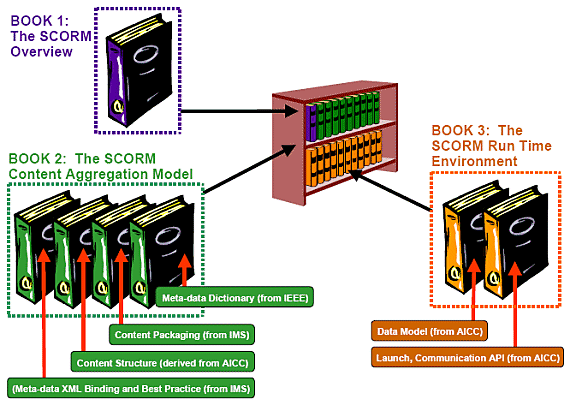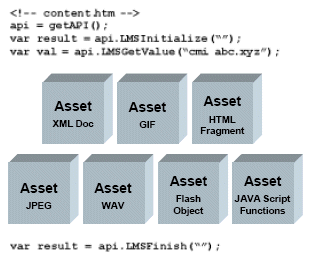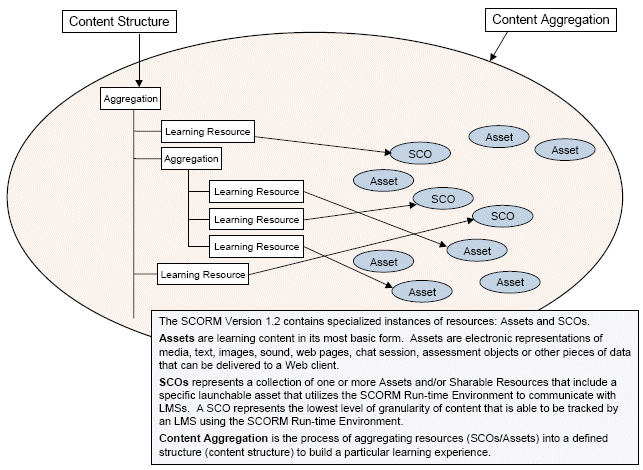I’ve had a bit of a break since I released VS SCORM 1.2 RTE Rev 1.0. But now it’s time to get back to the task in hand. At this time, I should be able to run any SCORM 1.2 SCO (‘Shareable Content Object’ in case you’d forgotten) that’s been installed in my ‘imaginary’ LMS.
Now it’s time to shift attention to another part of the SCORM specification – the Content Aggregation Model or ‘CAM’ for short. You can download a copy from the ADL website, or from [here].

Structure of the SCORM 1.2 Documentation
The CAM specification consists of 3 main parts:
- The SCORM Content Aggregation Model – defines what a “content aggregation” actually consists of, and the nomenclature that’s used to describe the various parts.
- Meta-Data – talks about how you can catalog and describe the content so that other people can figure out what it is, and whether it’s going to be useful to them.
- Content Packaging – describes how to bundle everything up so that it can be transferred from place to place, and how to create the imsmanifest file that’s used to catalog all of the pieces contained in the content aggregation.
I’m going to start with the first of these and just see how far I get in this post. As before, I’m going to focus on aspects of the specification that are mandatory and try to avoid getting bogged down in optional features. I began to examine the CAM when I talked about Courses and SCOs in an earlier post. So I’m going to reproduce part of that post here.
According to the SCORM 1.2 Content Aggregation Model specification, a ‘content aggregation’ consists of a collection of:
- Assets such as Flash objects, JPEG images, XML documents …
- “Shareable Content Objects” or SCOs for short
The specification says this:
SCOs are intended to be subjectively small units, such that potential reuse across multiple learning objectives is feasible.
In other words, an SCO is intended to be a little piece of ‘education’ (for lack of a better word) that can be assembled with other SCOs to create a larger piece of ‘education’. It further defines a SCO as follows:
A Shareable Content Object (SCO) represents a collection of one or more Assets that include a specific launchable asset that utilizes the SCORM Run-Time Environment to communicate with Learning Management Systems (LMSs).
and it illustrates the relationship between SCOs and Assets like this:

As the figure shows, an SCO is, itself, an asset (an HTML fragment) that includes the LMSInitialize() and LMSFinish() calls I talked about earlier, and may also reference/include other assets as required.
At the next level up, a Content Aggregation can contain one or more SCOs, and a collection of Assets. This is how the structure is illustrated in the SCORM CAM specification.

Meta-data can be used to descibe the content of Assets, SCOs and Content Aggregations. The first part of the CAM specification doesn’t actually say much about the structure/format of this meta-data – that’s going to be covered in the next section.
So, to try to summarise what I know so far:
A Content Aggregation is a collection of one or more SCOs (little pieces of ‘education’) and Assets (the resources required to make the SCOs work), together with meta-data that describes what the Aggregations, SCOs and Assets are.
Next time … more about meta-data.
